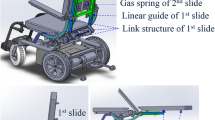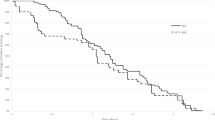Abstract
Background
Shear forces related to friction are one of the risk factors shown to increase the likelihood of wheelchair users developing pressure injuries (PIs), especially in the buttocks region. Thus, reducing the coefficient of friction between the seat and the person’s pants could be a means toward reducing the incidence of PIs.
Objective
This study aimed to: (1) determine the coefficients of friction of seven commonly worn pant fabrics and two seat cover fabrics and (2) investigate the effects of a deformable seat cushion on the measurement of the coefficients of friction.
Methods
A mechanical system (termed sled) had a pants fabric secured to its bottom and was placed on top of a custom seat pan with seat cover. The seat pan was tilted from horizontal until the sled system started to slide on the seat pan. The coefficient of friction between the two fabrics was calculated using kinematics data obtained from a motion capture system.
Results
The office fabric seat cover produced smaller coefficient of friction than the vinyl seat cover for all of the pant fabrics. Women’s khakis demonstrated one of the smallest coefficients of friction, and denim demonstrated one of the largest coefficients of friction consistently across both seats covers.
Conclusion
Replacing traditional vinyl seat covers in wheelchairs with a fabric closer to an office seat fabric is one approach to reducing frictional forces at the seat interface. Although optimal pant fabrics can be identified for shear force reduction, the results also depend on the seat cover fabric.








Similar content being viewed by others
Data Availability
The raw data required to reproduce these findings are available from authors on request.
References
Williams E, Hurwitz E, Obaga I et al (2017) Perspectives of basic wheelchair users on improving their access to wheelchair services in Kenya and Philippines: a qualitative study. BMC Int Health Hum Rights 17:1–12. https://doi.org/10.1186/s12914-017-0130-6
Brault, M. W. (2012). Americans with disabilities: 2010. Report Number P70-131 Washington, DC: US Department of Commerce, Economics and Statistics Administration, US Census Bureau. https://www.census.gov/library/publications/2012/demo/p70-131.html. Accessed 30 Dec 2023
World report on disability (2011) World Health Organization. Available at: https://www.who.int/publications/i/item/9789241564182. Accessed 30 Dec 2023
Torkia C, Reid D, Korner-Bitensky N et al (2015) Power wheelchair driving challenges in the community: a users’ perspective. Disabil Rehabil Assist Technol 10:211–215. https://doi.org/10.3109/17483107.2014.898159
Ferreira AF, Leite AD, de Pereira L et al (2021) Wheelchair accessibility of urban rail systems: some preliminary findings of a global overview. IATSS Res 45:326–335. https://doi.org/10.1016/j.iatssr.2021.01.003
Warner MB, Mason BS, Goosey-Tolfrey VL, Webborn N (2022) Physical activity levels and shoulder pain in wheelchair users during COVID-19 restrictions. Disabil Health J 15:101326. https://doi.org/10.1016/j.dhjo.2022.101326
Chang L-S, Ke X-W, Limroongreungrat W, Wang YT (2022) Relationship between Shoulder Pain and joint reaction forces and muscle moments during 2 speeds of Wheelchair Propulsion. J Appl Biomech 65:1–8. https://doi.org/10.1123/jab.2022-0066
Gould LJ, Bohn G, Bryant R et al (2019) Pressure Ulcer summit 2018: an interdisciplinary approach to improve our understanding of the risk of pressure-induced tissue damage. Wound Repair Regen 27:497–508. https://doi.org/10.1111/wrr.12730
Wood J, Brown B, Bartley A et al (2019) Reducing pressure ulcers across multiple care settings using a collaborative approach. BMJ Open Qual 8:e000409. https://doi.org/10.1136/bmjoq-2018-000409
Hubli M, Zemp R, Albisser U et al (2021) Feedback improves compliance of pressure relief activities in wheelchair users with spinal cord injury. Spinal Cord 59:175–184. https://doi.org/10.1038/s41393-020-0522-7
Hajhosseini B, Longaker MT, Gurtner GC (2020) Pressure Injury. Ann Surg 271:671–679. https://doi.org/10.1097/SLA.0000000000003567
Cox J, Schallom M, Jung C (2020) Identifying risk factors for pressure injury in adult critical care patients. Am J Crit Care 29:204–213. https://doi.org/10.4037/ajcc2020243
Strazzieri-Pulido KC, Carol CV, Nogueira PC et al (2019) Pressure injuries in critical patients: incidence, patient-associated factors, and nursing workload. J Nurs Manag 27:301–310. https://doi.org/10.1111/jonm.12671
Daniel R, Abai B (2019) Management of pressure injuries in neurosurgical patients. Medical Management of Neurosurgical Patients. Oxford University Press; 2019: 190-212
Russo CA, Elixhauser A (2006) Hospitalizations Related to Pressure Sores, 2003: Statistical Brief #3. Healthcare Cost and Utilization Project (HCUP) Statistical. Briefs 65:1–7
Gefen A (2018) The future of pressure Ulcer prevention is here: detecting and targeting inflammation early. EWMA J 19:7–13
Padula WV, Mishra MK, Makic MBF, Sullivan PW (2011) Improving the quality of pressure Ulcer care with prevention a cost-effectiveness analysis. Med Care 49:385–392. https://doi.org/10.1097/MLR.0b013e31820292b3
Coleman S, Gorecki C, Nelson EA et al (2013) Patient risk factors for pressure Ulcer development: systematic review. Int J Nurs Stud 50:974–1003. https://doi.org/10.1016/j.ijnurstu.2012.11.019
Horn SD, Bender SA, Bergstrom N et al (2002) Description of the National pressure Ulcer Long-Term Care Study. J Am Geriatr Soc 50:1816–1825. https://doi.org/10.1046/j.1532-5415.2002.50510.x
Sonenblum SE, Sprigle SH (2011) The impact of tilting on blood flow and localized tissue loading. J Tissue Viability 20:3–13. https://doi.org/10.1016/j.jtv.2010.10.001
Gefen A (2007) The biomechanics of sitting-acquired pressure ulcers in patients with spinal cord injury or lesions. Int Wound J 4:222–231. https://doi.org/10.1111/j.1742-481X.2007.00330.x
Shaked E, Gefen A (2013) Modeling the effects of moisture-related skin-support friction on the risk for superficial pressure ulcers during patient repositioning in Bed. Front Bioeng Biotechnol 1:1–7. https://doi.org/10.3389/fbioe.2013.00009
Edsberg LE, Black JM, Goldberg M et al (2016) Revised National Pressure Ulcer Advisory Panel pressure Injury Staging System. J Wound Ostomy Cont Nurs 43:585–597. https://doi.org/10.1097/WON.0000000000000281
Manorama AA, Baek S, Vorro J et al (2010) Blood perfusion and transcutaneous oxygen level characterizations in human skin with changes in normal and shear loads - implications for pressure Ulcer formation. Clin Biomech Elsevier Ltd 25:823–828. https://doi.org/10.1016/j.clinbiomech.2010.06.003
Shirogane S, Toyama S, Takashima A, Tanaka T (2020) The relationship between torso inclination and the shearing force of the buttocks while seated in a wheelchair: preliminary research in non-disabled individuals. Assist Technol 32:287–293. https://doi.org/10.1080/10400435.2018.1547333
Bush TR, Hubbard RP (2007) Support force measures of midsized men in seated positions. J Biomech Eng 129:58–65. https://doi.org/10.1115/1.2401184
Scott J, Bush TR (2022) Shifting loads as a result of chair articulations and associated perfusion responses in the context of pressure injuries: an investigation with able-bodied individuals. J Tissue Viability 31:104–111. https://doi.org/10.1016/j.jtv.2021.10.001
Scott J, Bush TR (2021) Key Components related to pressure Injury formation: an initial investigation into pressure distribution and blood perfusion responses in Wheelchair users. J Biomech Eng 143:1–7. https://doi.org/10.1115/1.4051888
Fontaine R, Risley S, Castellino R (1998) A quantitative analysis of pressure and Shear in the effectiveness of support surfaces. J Wound Ostomy Cont Nurs 25(5). https://journals.lww.com/jwocnonline/Fulltext/1998/09000/A_Quantitative_Analysis_of_Pressure_and_Shear_in.6.aspx
Hanson D, Langemo DK, Anderson J et al (2010) Friction and shear considerations in pressure Ulcer development. Adv Skin Wound Care 23:21–24. https://doi.org/10.1097/01.asw.0000363489.38996.13
Manorama A, Meyer R, Wiseman R, Bush TR (2013) Quantifying the effects of external shear loads on arterial and venous blood flow: implications for pressure Ulcer development. Clin Biomech Elsevier Ltd 28:574–578. https://doi.org/10.1016/j.clinbiomech.2013.04.001
Ajayi JO (1992) Fabric smoothness, friction, and handle. Text Res J 62:52–59. https://doi.org/10.1177/004051759206200108
Ajayi JO (1992) Effects of Fabric structure on Frictional properties. Text Res J 62:87–93. https://doi.org/10.1177/004051759206200205
Sülara V, Öner E, Okur A (2013) Roughness and frictional properties of cotton and polyester woven fabrics. Indian J Fibre Text Res 38:349–356
Ajayi JO, Elder HM (1994) Comparative studies of Yarn and Fabric Friction. J Test Eval 22:463–467. https://doi.org/10.1520/JTE12665J
Moorthy RR (2015) Surface friction characteristics of Woven fabrics with nonconventional fibers and their blends. J Text Appar Technol Manage 9(3). https://jtatm.textiles.ncsu.edu/index.php/JTATM/article/view/7307
He C, Shi P (2022) Interface pressure reduction effects of wheelchair cushions in individuals with spinal cord injury: a rapid review. Disabil Rehabil 44:827–834. https://doi.org/10.1080/09638288.2020.1782487
Lima M, Hes L, Vasconcelos R, Martins J (2005) Frictorq, accessing fabric friction with a novel fabric surface tester. Autex Res J 5:194–201
Jeddi AAA, Arshi A, Maleki V, Fakhr V (2006) Relations between fabric structure and friction. Part III: Warp knitted fabrics. J Text Inst 97:103–109. https://doi.org/10.1533/joti.2005.0115
Mendes PVB, Gradim LCC, Silva NS et al (2019) Pressure distribution analysis in three wheelchairs cushions of subjects with spinal cord injury. Disabil Rehabil Assist Technol 14:555–560. https://doi.org/10.1080/17483107.2018.1463399
Kanaga Karuppiah KS, Bruck AL, Sundararajan S (2009) Evaluation of friction behavior and its contact-area dependence at the micro- and nano-scales. Tribol Lett 36:259–267. https://doi.org/10.1007/s11249-009-9483-x
Yoon ES, Singh RA, Oh HJ, Kong H (2005) The effect of contact area on nano/micro-scale friction. Wear 259:1424–1431. https://doi.org/10.1016/j.wear.2005.01.033
Baby R, Mathur K, Denhartog E (2021) Nondestructive Quantitative Evaluation of Yarns and fabrics and determination of contact area of fabrics using the X-ray Microcomputed Tomography System for skin-Textile Friction Analysis. ACS Appl Mater Interfaces 13:4652–4664. https://doi.org/10.1021/acsami.0c18300
Zhai W, Bai L, Zhou R, Fan X, Kang G, Liu Y, Zhou K (2021) Recent progress on wear-resistant materials: designs, properties, and applications. Adv Sci 8(11). John Wiley and Sons Inc. https://doi.org/10.1002/advs.202003739
Kusy RP, Whitley JQ (1990) Effects of surface roughness on the coefficients of friction in model orthodontic systems. J Biomech 23:913–925
Acknowledgements
The authors would like to thank Dr. Justin Scott from the Biomechanical Design and Research Laboratory (BDRL)for his prior work in the area of friction. The authors would also like to thank the members of the BDRL for their support during data collection and analysis.
Funding
The authors did not receive support from any organization for the submitted work.
Author information
Authors and Affiliations
Corresponding author
Ethics declarations
Competing Interests
The authors have no relevant financial or non-financial interests to disclose.
Additional information
Publisher’s Note
Springer Nature remains neutral with regard to jurisdictional claims in published maps and institutional affiliations.
A. Lamsal is a member of SEM.
Rights and permissions
Springer Nature or its licensor (e.g. a society or other partner) holds exclusive rights to this article under a publishing agreement with the author(s) or other rightsholder(s); author self-archiving of the accepted manuscript version of this article is solely governed by the terms of such publishing agreement and applicable law.
About this article
Cite this article
Lamsal, A., Bush, T.R. Determination of the Coefficients of Friction Between Pant Fabrics and Seat Covers. Exp Mech 64, 261–273 (2024). https://doi.org/10.1007/s11340-023-01022-0
Received:
Accepted:
Published:
Issue Date:
DOI: https://doi.org/10.1007/s11340-023-01022-0




